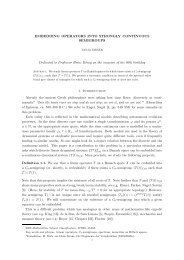Dutch Nao Team - Universiteit van Amsterdam
Dutch Nao Team - Universiteit van Amsterdam
Dutch Nao Team - Universiteit van Amsterdam
Create successful ePaper yourself
Turn your PDF publications into a flip-book with our unique Google optimized e-Paper software.
4.1 Architecture<br />
The program solves the game problem using a double state machine in the file soul.py. At the<br />
highest level are the states, which are the game states as specified by the gamecontroller. At<br />
a lower level are the phases, which are specific situations during a game. Transitions between<br />
the states and phases are made based on external input (conditions). For the states the<br />
external input are messages from the GameController and/or the button interface (see section<br />
4.4). For the phases the external input are based on observations (see section 4.2).<br />
Zoiets?<br />
BallFound <br />
<br />
<br />
BallNotFound <br />
ball seen<br />
ball lost<br />
ball lost<br />
ball too far<br />
<br />
Kick<br />
ball close<br />
In each of these phases, checks are made to see if conditions for transition are met (e.g. if<br />
in BallFound phase and ball close enough for a kick, go to Kick phase). An ad<strong>van</strong>tage of this<br />
approach is that the main problem, playing a game of soccer, is divided into smaller problems<br />
which can be solved independently and locally. A second ad<strong>van</strong>tage is that phases can be tested<br />
without executing the entire program. In effect, the tests are less time-consuming. On the other<br />
hand, the <strong>Nao</strong> is not able to process circumstances that aren’t specified in a phase. The solution<br />
implemented is a straightforward one where phases can not be interrupted until they have finished.<br />
This would not, or less so, be the case if a single program covered the entire game problem.<br />
[Arnoud]: Unpenalized phase not introduced!<br />
Except for the Unpenalized phase, a phase contains the following:<br />
• A call to receive visual information and, if needed, further processing of this information<br />
• One or more condition checks for transition to other phases<br />
• One or more motion calls<br />
• Optional: print statements for debugging purposes<br />
As each phase is implemented as a Python function, it can be called independently. Our<br />
system thus works as a loop calling the function corresponding to a game phase. It should be<br />
noted that the phase can be changed in each state but the corresponding function is only called<br />
in the Playing state.<br />
4.2 Vision<br />
Justin, Michael, Anna, Robert?<br />
4

















